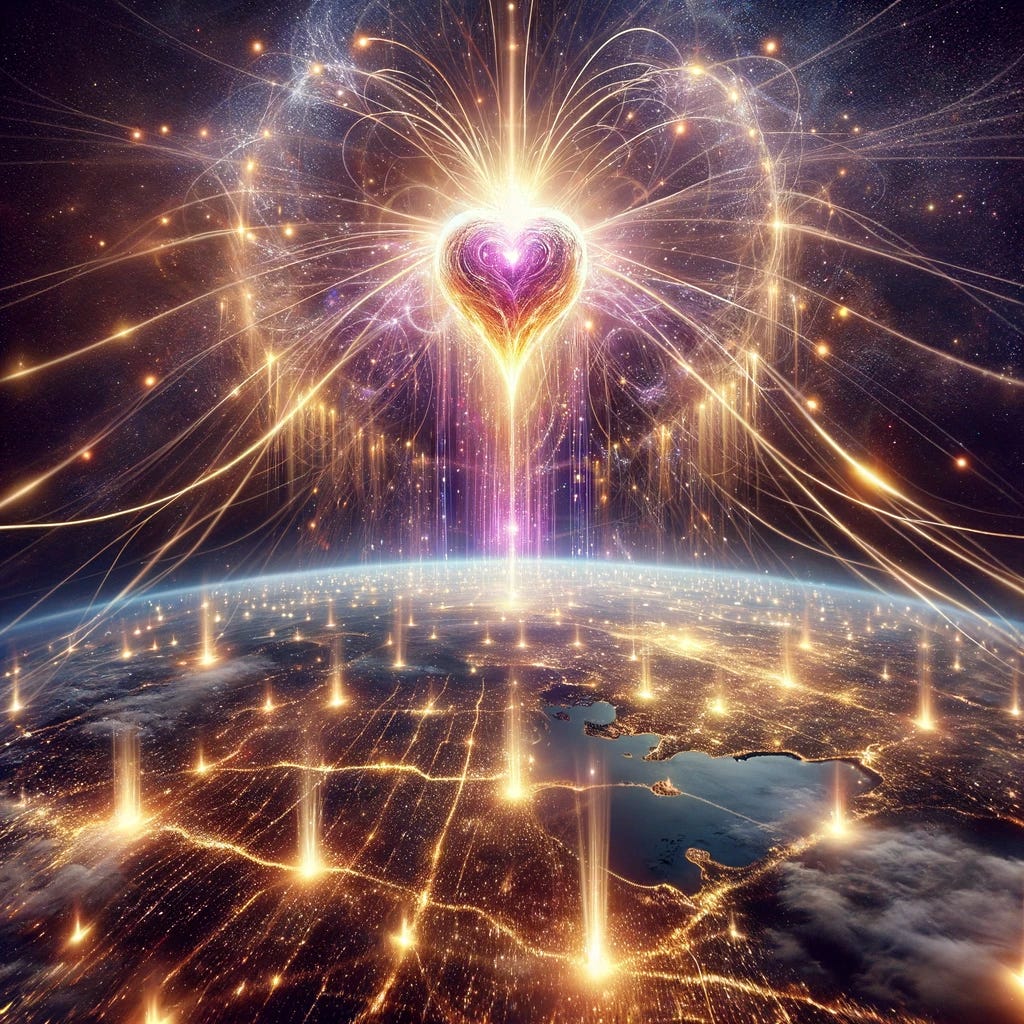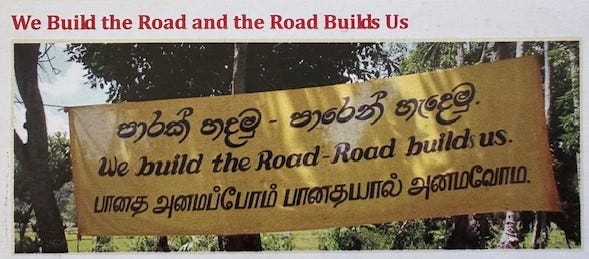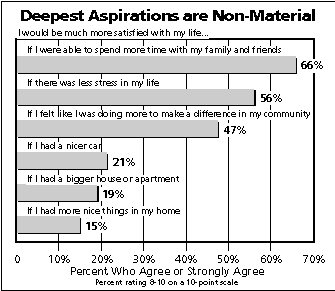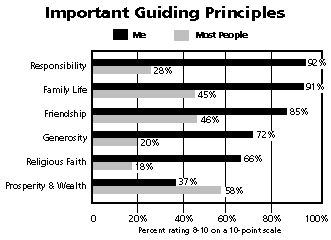The Conscious Community Network and Local Food Ecosystem, Chapter 7 Part 1
Welcome to the Birthing the Symbiotic Age Book!
NEW here? — please visit the TABLE OF CONTENTS FIRST and catch up!
You are in Chapter 7, Part 1, A “Conscious Community Network” Ecosystem -- Building Community Capacity … The Culture of Separation – A Deeper Look
Chapter 7 posts:
Are you trying to figure out where this is All Going? Read an overview of the Symbiotic Culture Strategy, which embodies the Transcendent through the nodes of intersection within local, grassroots-empowered community networks.
Voice-overs are now at the top of my posts for anyone who doesn’t have the time to sit and read! Also, find this chapter post and all previous posts as podcast episodes on
Spotify and Apple!
Previously, at the end of Chapter 6:
Self-rule begins with self-control, ruling over oneself – meaning restraining selfish impulses, adhering to the truth, and serving family, neighbors, and society to attain uplift for all. Self-rule is the foundation for self-government – beginning with the village.
Swaraj (self-rule) and Swadeshi (communal kinship) are the practical founding principles for a truly virtuous economy and virtuous society, a Culture of Connection built parallel with existing society. Think of this infrastructure, this scaffolding, as concentric radiating circles.
Wrote Mahatma Gandhi:
"In this structure composed of innumerable villages, there will be ever-widening, never-ascending circles. Life will not be a pyramid with the apex sustained by the bottom. But it will be an oceanic circle whose center will be the individual, always ready to perish for the village, the village ready to perish for the circle of villages…therefore the outermost circle will not wield power to crush the inner circle but give strength to all within and derive its own from the center.”
While this might sound awfully idealistic, I want to remind you that this is ALREADY happening in the national network of 5,000 villages and towns in Sri Lanka. In subsequent chapters, I will share more personal stories that show how it is possible and practical to implement these beautiful ideas in a medium-sized urban city.
While nobody in our Reno symbiotic networks offered to “perish for the village,” we did indeed practice and promote the interreligious ideas of Swaraj and Swadeshi, Solidarity and Subsidiarity. In doing so, we transformed the economy and politics of the Reno region from the inside out and from the grassroots up.
SPECIAL NOTE: I wanted to inform you that I will be interviewed live in an
"Awakin Call" this Saturday, May 11th, at 6:30 PM Pacific Time. Awakin Calls are part of ServiceSpace, a global community network of 600,000 people, reaching millions monthly.
Chapter 7
The Conscious Community Network and Local Food Ecosystem
Introduction
I have always wondered what it will take to realize humanity’s dream of a Beloved Community, the dream that many of us have been holding in our hearts – a dream I still cherish, even after COVID and seemingly “forever” wars. How do we find a way forward and discover the courage to build a spiritually based global civilization from the division and fragmentation in ourselves, our communities, and the world?
I wanted to share from Section 1 the remainder of the poem I wrote:
Suffering is never alone but shared.
My heart bursts open as the energy of compassion streams through me. The blood from my open heart, so red, shoots up into the sky further and further.
Then, like a cloud burst, countless droplets begin to fall towards the Earth. In midflight, they change to flowers. A colored multitude of roses and lotus blossoms float downward in perfect harmony.
Falling with purpose and direction, they land in a wide ocean. They congeal in masses on the water, taking new shapes and forms. Arising from the flowers are rescue boats, many rescue boats moving slowly on the glistening surface of the sea.
Where are they going?
The boats move onward towards a tranquil island in the ocean. Now and then, a living being is seen in the water, lost in the boundless sea. On the boat, people of all kinds reach out and help those lost climb aboard to safety.
Together, they go in Universal Kinship to help everyone, all heading for the same shore, the same island of unlimited joy and boundless love—the island inside us, found in the silence of the still heart.
Suffering is never alone but shared.
Can we hold on to this beautiful dream of a unified humanity, even in the midst of the chaos, violence, and confoundment of modern life? How do we take the next step by joining our smaller lights together to make the dream a reality and illuminate the way for others?
Those were the questions in my heart and on my mind as I reflected on the initial success of our buy local campaign and what we called the Local Living Economy Network as we sought to take the next steps.
Over the next two years, our group continued to meet monthly for breakfast meetings, and those of us involved noticed two positive effects.
First, there was a new sense of grassroots empowerment. As you may remember, the entire network was launched in response to a felt need to unify our community to address the political polarization around the 2003 Iraq War. The fact that there was an “invasion” of big box stores into the local economy also created a strong incentive for the network’s growth.
Now the question was, could our community build on our momentum despite the lack of a dire, imminent crisis?
People wanted to shift economic power from Wall Street “extractors” to Main Street sustainers. Local businesses were indeed thriving, and there was a sense of agency and independence. Unlike so many communities being “colonized” by larger entities, Reno held its own and then some.
Our network created another benefit that was more “internal.” As our working together “built the road’ to economic self-reliance and locally generated prosperity, the road built us as well. Hierarchies were “flattened,” and there was a palpable, new experience of Trust within our expanding circles of business owners and community leaders, caring activists, and citizens.
As people emerged from their “silos,” there was a desire to collaborate even further. What else could we do now that we’d built a successful “buy local” movement through our network?
A “Conscious Community Network” Ecosystem -- Building Community Capacity
We had built an “ecosystem” of core leaders dedicated to mutual benefit in our community, and now we wanted to build on our success and make sure the buy local campaign wasn’t just a “one-off.” We shortened our name to Conscious Community Network and began discussing the bigger picture and what could be next.
We knew we didn’t want to take the usual “well-worn path” of activism, which has two pitfalls. First, there is a tendency to identify an “enemy” and fight against him, her, or it. Secondly, not only does the Culture of Separation separate us from one another, but it also separates us from the Transcendent Ground of Being, just as it has made science and spirit two mutually exclusive, rather than complementary, domains.
Activists commonly take the path of social, political, and economic action, seeking to change society from the outside without focusing on our interior life.
Others have tried the path of religion and spirituality, emphasizing individual salvation or enlightenment in the context of their religious/spiritual groupings without focusing on fundamentally changing society's exterior life.
Even though the outer and inner paths are two aspects of the same reality, let the Culture of Separation get them to fight one another!
How often have we heard religious and spiritual folks who don’t want to “dirty their hands” by getting involved with politics?
Or social activists complaining that spiritual practice is a narcissistic indulgence that is irrelevant to making real changes in the real world?
That’s why Sarvodaya is such a shining role model and a blessing to the world. It seamlessly integrates the inner and outer, the spiritual and practical, by focusing on universal virtues and principles that reflect the Transcendent and its network structure that mimics the web of nature.
There is something else about Sarvodaya that is largely invisible to the Western eye—not only does their networked community flatten domination hierarchies, but it flattens a Western icon, Maslow’s Hierarchy of Needs. As we discussed earlier, our Western view of progress imagines that we first handle our basic economic needs, and then, when we have enough leisure time, we can contemplate a spiritual life.
Sarvodaya made the spiritual life a “bottom line” that helped build community and financial well-being and radiated benefits that impacted all other aspects of life in Sri Lanka, effectively turning that Maslow pyramid on its head.
Even if we didn’t speak about it, conscience and consciousness informed our Reno network from the beginning. When we renamed our endeavor “Conscious Community Network,” the word “conscious” wasn’t some new age, throwaway catchphrase. It indicated that the virtues that flowed from the universal Ground of Being were the foundation of our community and network.
Two other things became clear from our experience in the buy local network. First, we recognized that our project worked because it was “regional,” not too big or too small. Ours was a “micro-bioregional” approach that included not just the city and suburbs of Reno but the Northern Nevada surroundings, which included rural areas, watersheds, and a diverse population.
At the same time, our territory was small enough for people to connect face-to-face. Our own Washoe County had a population of 400,000 at that time, dispersed over a 50-mile range. That felt like the optimum network size—big enough to include diverse populations, natural systems, and economic activity—and small enough for meaningful personal, social, cultural, and economic interactions.
The other thing that became clear is that, like Sarvodaya, we wanted to unite our community around common universal principles, Virtues, and values. In the next chapter, “What Will Unite Humanity?” we'll discuss our process for crowd-sourcing and community “sensing collective intelligence” these virtues in more detail.
In looking to build on the success of our living economy network, three principles emerged:
First principle: We are all in this together. Deep down, we share a common, transcendent spiritual sense—holding all life and the world as one and interconnected.
The Second principle: We all share common concerns, virtues, and a desire to be of service.
Third principle: We focus on the positive and what we are for, addressing common community needs instead of what we are against.
I think one of the most significant reasons why we were able to bring our whole community together was that we focused on common, local concerns and acted to build on those. Remember, we spent no energy picketing Walmart; we focused on “magnetizing” more people to local businesses/organizations and energizing this new local Culture of Connection.
Without labeling it as such, this new culture deepened practical spiritual development and inspired us to find a common purpose and vision beyond any individual agenda. As Proverbs tells us, “Where there is no vision, the people perish.”
We wanted our people to thrive!
Our vision boiled down to three “pillars”: build a cooperative community, strengthen the local economy, and practice living more consciously.
Here is how we expressed it at the time:
Build a Cooperative Community. Catalyze networks that address the building blocks or infrastructure of a strong community.
Strengthen our Local Economy. Encourage all stakeholders to shift their purchasing, investment, and banking to the community-based local economy.
Practice Living more Consciously. Engage the community to practice the Virtues of love, sharing, cooperation, and kindness in daily life and business while encouraging personal responsibility to build strong families and a tighter-knit community.
I have a caveat here. First, I present these practical ideals not as “commandments” but as guidelines. We wondered whether creating a universally supportive network infrastructure was possible while respecting every local region's uniqueness. I’ve since discovered that to spread or “scale,” the new system must “build capacity”- a way to proliferate the new cultural ideals into the real-world community. That’s another reason for “radical inclusivity.”
Had we confined our buy local network only to enterprises we considered regenerative or “organic,” we would never have built the capacity to make the changes in our region, which you’ll read about in this chapter and the next chapters.
Sarvodaya used what it called “Sarvodaya Societies” to build the new “radically inclusive” culture locally, as “fractals” of the abiding concept; we build the road, and the road builds us.
In Part III, we’ll present the practical plan for each community to build its own Symbiotic Society, based on my practical experience with building the Conscious Community Network and the Symbiotic Networks— where local groups of initiators and catalytic connectors consciously plant the seeds of symbiotic culture so that it can flower in many communities simultaneously.
Another reason for our success was that instead of relying on outside experts, we used “commonly-sensed” common sense found within our community. From that beginning, we forged a network of 500 businesses and organizations focused on some of the building blocks (local food, energy, economy), and we later created both web-based and physical directories to promote community support of our local economy and local charities.
One of the documents that both influenced and reinforced our work in those early days of Conscious Community Network was from a mid-1990s study by the Merck Family Fund (connected to Merck & Co., Inc., an international pharmaceutical company) entitled “Yearning for Balance.”
Some of the findings were:
85% feel our priorities are ‘out of whack’ — with materialism, greed, and selfishness increasingly dominating American life and crowding out more meaningful values based on family, responsibility, and community.
People are alarmed about the future — feeling the material side of the American Dream is spinning out of control.
People are ambivalent about making changes in their lives and in society. They want financial security and material comfort, but their deepest aspirations are non-material.
Without directly confronting the Culture of Separation or the secular religion of materialism, the Merck study reiterated most people's longing for what Martin Luther King called a “Beloved Community” and intentional mutual benefit. Survey respondents expressed a strong desire for a greater sense of balance in their lives — not to repudiate material gain but to bring it more into proportion with the non-material aspects of life.
As I write this almost 30 years later, we can see how prophetic that study was.
Things have not gotten better. All markers of societal dysfunction — depression and suicide, particularly among young people; homelessness and opioid addiction; metastatic student debt; polarization; government corruption; war; and, of course, the ever-growing gap between rich and poor — have indicated things have gotten worse.
It seems like the “unconscious non-community” of the Culture of Separation has become even more firmly entrenched in the world at large. At the same time, we truly created a “counterculture” that defied this trend. The Culture of Connection we were quietly building in Reno was not based on some abstract theoretical notion. Rather, it addressed many real-life concerns the Merck study revealed.
First, our work re-prioritized local agencies and communities, giving people a sense of empowerment even as things seemed more out of control in the world “out there.” Second, it really did buck the trend of a divided society in decline and revived the Main Street economy. Finally—and perhaps most importantly—it addressed the spiritual malaise underlying the Merck study by reinfusing the Virtues into our community life.
The Culture of Separation – A Deeper Look
I want to discuss what I have been calling a Culture of Separation a bit more so that you will understand how Symbiotic Culture, as a universal cultural change strategy, addresses the unique challenges of our Age.
As I’ve said throughout this book, most attempts to “change society” fail because they seek to mitigate individual problems from inside the Culture of Separation itself. This fails to address two key issues: First, the problems are interrelated and cannot be solved individually. Second, the Culture of Separation is the fundamental, underlying condition that keeps those problems in place.
As you recall from section I, this all-immersive, largely invisible Culture of Separation has some interlocking assumptions, primarily that reality comprises separate things—including humans.
Not only are we increasingly considered to be “things” to be used and discarded, but this “only matter matters” worldview has separated us from the Transcendent, from nature, and from each other.
This materialistic view of life and reality denies the existence of a “Ground of Being” or “Transcendent Order” undergirding “Reality.”
To summarize, the primary beliefs / interlocking assumptions of the Culture of Separation and its shared, overarching worldview are:
We’re all separate from one another.
The world is made of things to be used.
Life is all about our individual desires and “happiness.”
The Highest Good is having and consuming things - while seeking pleasure and avoiding pain
There is no objective “Reality” or “Truth.”
There is no shared basis for morality.
The rational mind and new technology will solve all of our problems.
The overarching premise is “perpetual economic growth equals progress.”
This is how we are taught the world is, how society “forms” us.
The Culture of Separation, which has obviously been operative throughout the rise and fall of empires over the last three thousand years, has been intensified in a society — and now a world — obsessed with individualism and serving individual desires, even spiritual ones.
“Love thy neighbor” has devolved into a focus on individual salvation or enlightenment — within our institutional, siloed religious, spiritual, and even secular tribal enclaves.
The very Power of the Transcendent has been “domesticated" by the Culture of Separation, confined to religious (or secular) silos and an “us and them” worldview. Instead of “comforting the afflicted” and “afflicting the comfortable,” “captured” religion tends to reinforce the status quo. It’s only when we break out of these silos that we allow the trapped, Cosmic Love, an actual Transcendent, loving energy to flow through our existing systems.
The matrix we live in is even more immersive than we imagine or feel.
Today, we’re divided by faux “customized worldviews/realities” based on “likes,” emojis, notifications, endless scrolling, messages/texting, unending entertainment, social media, gaming, narcissistic “leaders” hellbent on self-aggrandizement, and an “anything goes” attitude that shows a complete lack of respect and disregard for anyone or anything else.
And “godlike” technology has given us access to that at our fingertips 24/7.
While all these trends have exacerbated the problem, the Culture of Separation is not new. Every empire in history had its own “self-destruction” phase because greed and selfishness prevailed over care for “the least of us.” In our own times, we seem to have further fragmented into self-interested tribes and silos -- even those amongst us “doing good" — as people have been distracted and diverted into culture wars.
As I suggested in the introduction, historians Arnold Toynbee and Oswald Spengler agreed that the epitaph on the grave of every fallen empire is the same:
Died of spiritual and moral decline!
Toynbee states a sign of decline is the growing gap between the haves and the have-nots. When society focuses primarily on material possessions and the pursuit of comfort and self-interest, when citizens and organizations care more about their ego needs than that of the community, the gap widens, and society breaks down. Toynbee maintained that it was more a spiritual than an economic issue.
He wrote that when people stopped caring for one another, this was a sign of “moral decline.” Hence, the epitaph. This has happened repeatedly, and the result is a world that is broken and sick at heart.
Yet, despite being surrounded on all sides by this all-pervasive Culture of Separation, our group in Reno empowered a “conscious community network”– a parallel functional system operating alongside the failing dysfunctional one. Even though we still operated inside the Culture of Separation—we had to because that’s where “reality” lives—we were also independent of it — we were in it but not “of” it.
In this “parallel reality,” our Conscious Community Network was focused on the Virtues and making the world “right-side” up by focusing on creating a local cultural change strategy — a Culture of Connection — and this desire to serve the entire community brought us to our next step.
Find out how we built a Local Food System Network in the NEXT POST — Chapter 7, Part 2: The Next Step – A Local Food Systems Network… Identifying Our Super-Connectors and “Multiple Stakeholders”… Building Our Network-Centric Ecosystem
PREVIOUS POST
TABLE OF CONTENTS
NEXT POST










Respect for the consciousness and dedication in your work to support the emerging symbiotic / complementary society. Being busy with my own work I often don't read . . . I came back this morning and resonating with your vision.